






I've been gardening and writing about gardening for more than 20 years, yet I find I'm always learning new things about the plants, insects and other critters that call my backyard home. That's the great thing about gardening — it's never boring! I've worked as a landscaper, on an organic farm, as a research technician in a plant pathology lab and ran a small cut-flower business, all of which inform my garden writing. A few years ago my husband and I purchased a beautiful old Victorian house and opened a pet-friendly B&B; I've spent the last few summers renovating garden beds and adding new ones. My husband once asked me when I'll be finished, to which I replied, "Never!" For me, gardening is a process, not a goal.
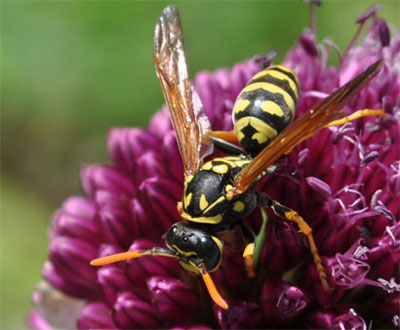
Difficult to distinguish from a yellow jacket, this is most likely a European paper wasp — a yellow jacket probably would have stung me before I could take the photo. Like the yellow jacket, it has a smooth, bright yellow and black body with a well-defined waist and thin legs.
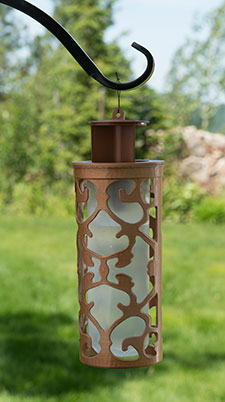
The OrnamenTrap Yellow Jacket Trap is a decorative way to trap yellow jackets in your outdoor living area. Catches queen yellow jackets in spring, and workers from summer through fall. Does not attract or harm honeybees.
YOU'RE outdoors enjoying a late-summer picnic and within minutes, dozens of yellow, flying insects intrude on your fun. People often think, "Bees!" but these uninvited guests are just as likely to be yellow jackets, a type of ground-nesting wasp. Often confused with bees, yellow jackets are much more aggressive, and most reported "bee stings" may in fact be yellow jacket stings. As a former hobby beekeeper, it's my duty to stand up for bees and set the record straight!
In spring and early summer, yellow jackets are carnivores, feeding mostly on insects to provide protein to developing larvae in their colony. In doing so, they help keep garden pests, such as caterpillars, in check. As the season progresses, their population grows and their diet changes to include more sugars. As natural food sources become scarce, they turn to scavenging, and that's when you'll find them lurking around garbage cans and pestering picnickers. A few yellow jackets here and there are a nuisance, but a nest of them in your yard can pose a real hazard.
Yellow jackets often nest underground in rodent burrows, so if you see lots of flying insects emerging from a hole in the ground, they're probably yellow jackets. By late summer, a colony may contain thousands of individuals that will aggressively defend their nests from intruders. They're easily provoked and will attack in force, chasing the perceived threat for large distances. What's worse, each yellow jacket can sting multiple times. Sounds and vibrations, such as those from a mower or trimmer, can trigger an attack, even from a distance.
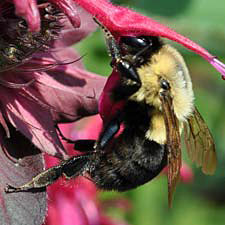
Bumblebees are much larger, plumper and fuzzier than honeybees.
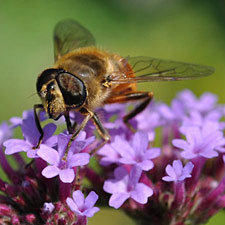
Closely resembling a honeybee, this non-stinging hoverfly is the gardener's friend. The larvae feed on insect pests, including aphids, scale, caterpillars, mealybugs and thrips. The adults pollinate flowers.
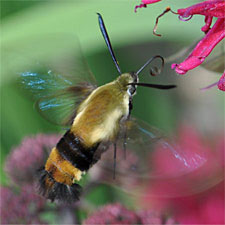
Many non-stinging insects, such as this hummingbird moth, have the same coloration as stinging insects.
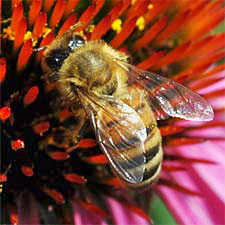
Honeybees have relatively plump and fuzzy bodies. Their hind legs are flattened, and you'll often see yellow pollen attached.
If a yellow jacket nest poses an immediate threat to passersby, including pets, then you may need to take actions (see When Yellow Jacket Control is Necessary, below). Be sure to positively identify the insects, however. You don't want to inadvertently destroy the nests of bees or other look-alikes.
Getting to know the habits of various flying insects will help you identify them and decide if they pose a serious enough threat that you need to take steps to control them. Here are some other common summer visitors; keep in mind that all, including yellow jackets, are beneficial in the garden, by eating pest insects and/or as pollinators.
Related: Yellow Jacket FAQPaper wasps and hornets, like yellow jackets, are social wasps (that is, they form colonies) but they nest aboveground. They also help control garden pests. Both can inflict nasty stings and can be aggressive, but they don't scavenge like yellow jackets and so are less likely to show up at outdoor activities.
Honeybees nest in cavities, such as hollowed out tree trunks (or in beekeepers' boxes). In contrast to yellow jackets, honeybees are relatively gentle (with the exception of Africanized honeybees). Bees that are out foraging among flowers for nectar and pollen usually sting only if stepped on or swatted. If you approach their nest, they'll defend it but only within the immediate area. They won't chase you hundreds of yards like yellow jackets will. A honeybee can sting only once. When it stings, its barbed stinger and the attached venom sac are ripped from its body, killing it. So the honeybee stings only as a last resort, sacrificing its life to protect the colony.
Bumblebees nest underground, but they are so big they're easy to distinguish from other bees and yellow jackets, and a colony rarely tops 100 individuals, in contrast to the thousands in a yellow jacket colony. Bumblebees will chase invaders and will pursue them further than honeybees, but they won't come out in droves like yellow jackets because their colonies are relatively small. Like a yellow jacket, an individual bumblebee can sting multiple times.
Some solitary bees nest in the ground but they don't form colonies (although several may nest near one another, giving the appearance of a colony). Solitary bees, such as mason bees, mining bees, leafcutter bees and sweat bees, rarely if ever sting and definitely don't gang up on intruders. Count yourself lucky if they call your garden home; they're great pollinators.
There are many nonstinging insects that resemble bees, too. Examples including hoverflies, bee flies and even hummingbird moths.
If you see thousands of honeybees in the sky or a huge mass clustered in a tree branch, just stand back and watch.
The bees are swarming. They've decided their colony is too large for the hive, so they've created a second queen bee, and half the bees and a queen are off to find a new home.
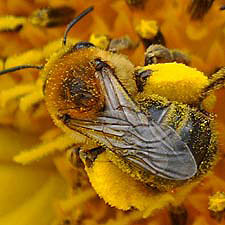
This honeybee is dusted with yellow pollen, which it will inadvertently transfer to other flowers as it gathers nectar and pollen to bring back to the nest.
The swarming bees are docile — their bellies are full of honey and they don't have a home to defend. If they alight in your yard, contact a local beekeeper who may be interested in capturing the swarm.
Here are some general tips on avoiding insect stings.
Yellow jacket traps can help keep the population of a nest in check if they're set out in spring and early summer, when the population in the yellow jacket colony is small. Later in the season, placing the traps around the perimeter of an outdoor seating area may help reduce their pestering, but the traps won't do much to reduce the overall population.
If you're stung by a bee, you may be near the nest; leaving the area will prevent further stings. A honeybee will leave its barbed stinger in your skin; remove it by scraping the sting site with your fingernail, a butter knife, a credit card or something similar. Don't try to pull it out or you'll squeeze the attached sac and inject more venom. Other bees and wasps don't leave their stingers behind so this step isn't necessary.
If you're stung by a yellow jacket, wasp or hornet, run! The insect may leave behind a chemical that marks you as the enemy, inciting other yellow jackets to attack. Don't swat at the insects, just get away quickly.
Seek medical help immediately if:
Anyone suspecting they are allergic should carry a bee sting kit, such as an epi-pen.
There are commercial sting remedies available, but many people swear by homemade concoctions. Apply any of the following to the sting site:
Ice will help reduce swelling and ease pain, as will aspirin and ibuprofen. Antihistamines and cortisone cream may reduce swelling and itching.
Whenever possible, leave yellow jacket nests alone and let them continue to prey on pest insects; the ensuing cold weather will cause the colony to die off. However, if the nest is in a well-traveled area and poses a risk, you may need to take action.
The easiest and safest the option is to hire a professional. If you're determined to do it yourself, know that the likelihood of getting stung is high. You can minimize the risk by hanging an imitation nest on your deck or patio. It acts as a natural deterrent for yellow jackets, wasps and other flying pests.
Apply control measures on a cool evening. The insects will be back home from the day's foraging, and they're more sluggish in cool temperatures. Always wear protective gear, ideally beekeeper's attire.
Smother them. Mike McGrath, host of WHYY's You Bet Your Garden talk show and former editor-in-chief of Organic Gardening magazine suggests this procedure: Fill a wheelbarrow with ice and quickly dump it over the hole. Then cover the hole and the area around it with a heavy tarp weighed down with bricks, a piece of sheet metal, a big wooden board, or other heavy object. Then cover that with soil or wood chips. Or cover the hole with a thick piece of clear plastic, seal the edges tight to the ground, and the nest will cook in the sun once the ice melts.
Boil or drown them. Some gardeners report success with pouring 10-plus gallons of boiling water into the nest. Other say soapy water does the same thing. Remember, any insects that you don't kill on contact will come after you.
Spray them. Numerous wasp control sprays are available, including organic ones with mint oil as the active ingredient. There are also sprays that freeze upon contact. Some people report better luck using pesticide dusts rather than sprays. If you choose one of these methods, follow label directions very carefully, taking all precautions.
Do NOT pour gasoline, kerosene or any other flammable or toxic liquid into the hole. If it doesn't kill on contact it will infuriate the insects. And it will poison the soil.
Although the appearance and sting of an individual Africanized honeybee are similar to those of a regular (European) honeybee, Africanized honeybees are far more dangerous. More akin to yellow jackets in their behavior, Africanized honeybees are easily provoked, attack in large numbers, and will pursue their victims over long distances, up to a quarter mile. They're also less particular about nesting sites and may set up home in any cavity, including places such as an overturned flowerpot, a tire or a mailbox.
Researchers brought African bees to Brazil in 1956; they escaped and began mating with European honeybees to produce the much more aggressive hybrids dubbed "Africanized bees." They reached the southern U.S. in 1990 and, although currently a threat in the southern tier of states as far north as Oklahoma and northern Utah, they're moving northward at a rate of about 200 miles per year.
Copyright © www.100flowers.win Botanic Garden All Rights Reserved